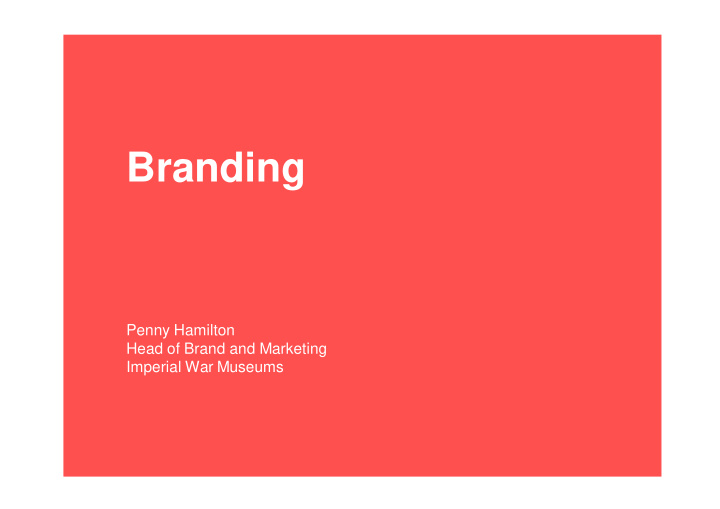



Branding Penny Hamilton Head of Brand and Marketing Imperial War Museums
Schedule Session 1: What is a brand? Session 2: The key elements of a brand Session 3: How to develop a brand Break Session 4: Case Study: The IWM brand
The ‘B’ word What is a brand?
The ‘b’ word – a whistle stop tour consistency difference quality
choice + identity more than a logo what we believe in how it makes us fee l
competition visitors staff exhibitions funding sponsorship media space influence policy
A clear idea who you are what you do why you do it how you do it + what you stand for
product communications environment behaviour
product or service communications communications communication idea environment behaviour environment
invitation to engage challenge to reconsider for both staff and public
always challenging always fresh always different always Tate
look again think again
product communications look again think again environment environment behaviour behaviour
product communications If you lived down here you'd look weird too The Power of Nature behaviour environment
Branding defined What are the key elements of a brand?
A brand defined the experience you offer the difference you make
The name Emotive Volksvagen Muji British Airways Starbucks Kodak Descriptive American Airlines Abstract Orange Nike Coffee Republic cahoot One World Inspirational
A brand defined VISION the impact you want to make OFFER what you do VALUES how you do it PERSONALITY the way you do it POSITIONING your difference BIG IDEA the heart of your brand THE NAME what audiences recognise
The big idea – a few examples A coherent story and a shared direction V&A “inspiring creativity” Royal Botanic Gardens Kew “plants matter” Natural History Museum “the power of nature” Apple “think differently”
The brand ‘blueprint’ Vision Positioning To advance our knowledge of A voice of authority on the the natural world, inspiring natural world better care of our planet Personality Values Idea Inspiring Diversity Courageous The power of nature One Museum Passionate Relevant science Clear Learning Compelling Fun Mission We maintain and develop our collections and use them to promote the discovery, understanding, responsible use and enjoyment of the natural world
consistency difference quality
Models for brand architecture
consistency difference quality
Offer Image What you do What you say communications communication idea environment People Where you do it How you behave Environment
Brand creation How to develop a brand?
Four Stages 1 Investigating: examining perceptions of the organisation overall and reviewing messages and identity 2 Visioning: creating a positioning framework for the organisation, including vision, values and ‘big idea’ 3 Visualising: reviewing visual and verbal expression against on this framework 4 Implementing: developing a phased action plan to embed the brand across the organisation
The brand ‘blueprint’ Vision Positioning The difference you The competitive want to make to the territory you own world Personality Values Idea The attitudes that The core principles The organisation’s differentiate you from that drive emotional essence your competitors behaviour Mission What you do and why you do it
Investigating • Desk Research – strategy and audience research • Exit Surveys • Online surveys – include social media: Facebook and Twitter • Internal and external interviews • Competitor and visual audits • Spend time just watching visitors
Investigating • Why do/don’t you visit? • What do you expect from your visit? • What do you like about your visit • What’s the best/worst thing about the organisation • What could be improved? • Can you describe the organisation’s logo • Where else do you visit? Who does it better and why? • How would you describe the organisation in 3 words?
Offer Visioning What you do 1. Where are you today? 2. What makes your organisation special? 3. What do you want your audiences to say? 4. Your market position? 5. A picture for the future?
Recommend
More recommend